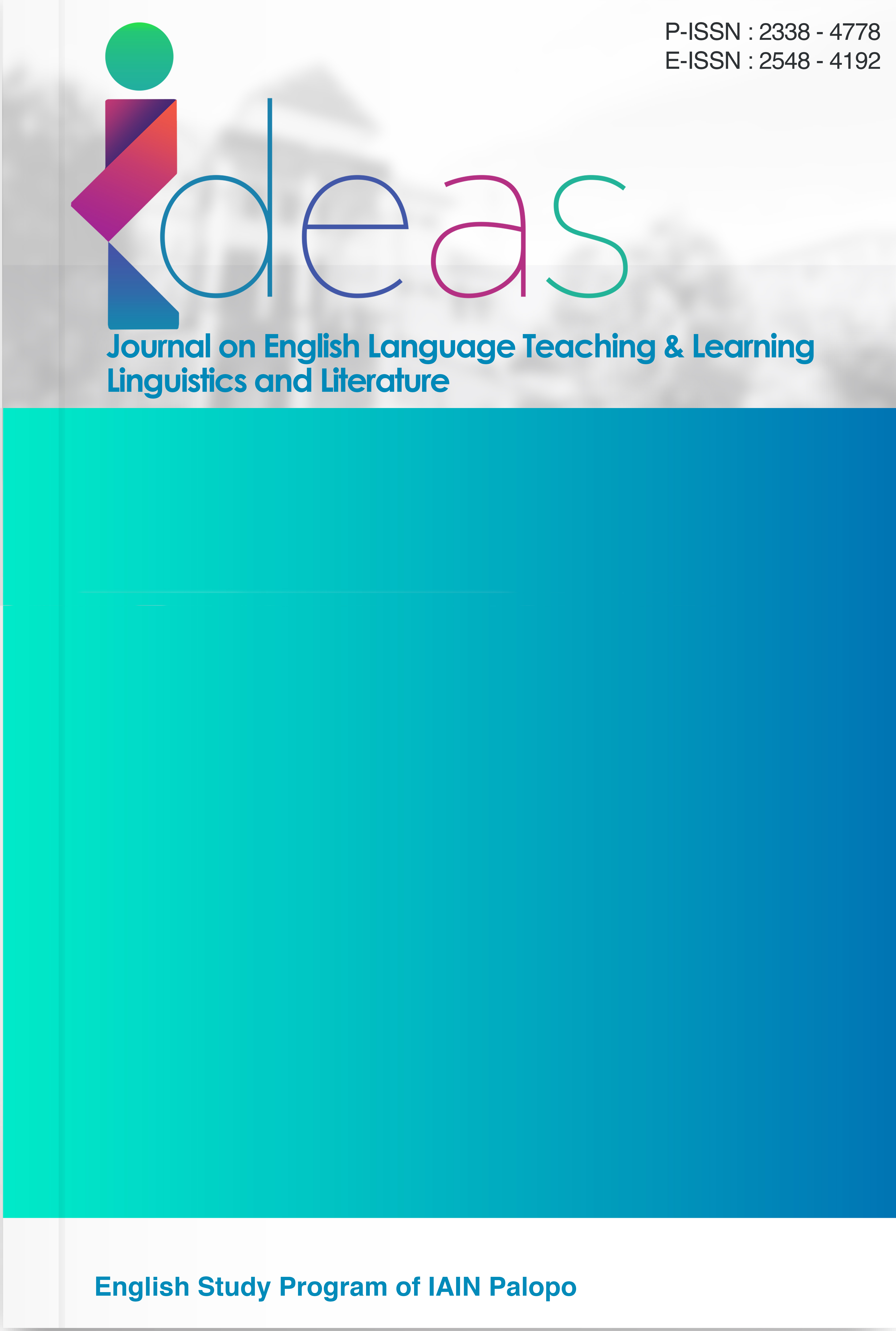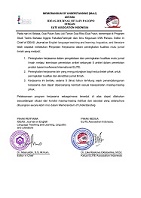Investigating Satirical Interpretation of Netizen Comments on Tiktok Toward Megawati
DOI:
https://doi.org/10.24256/ideas.v13i2.5076Keywords:
Satire, Netizen, Tiktok, MegawatiAbstract
Freely to express opinions is one of the reasons netizens use social media as a forum for expressing themselves. Through the comment’s column, netizens on TikTok use elements of satirical language to criticize, satirize Megawati with a sense of humor using polite and even vulgar language. The aim of this research is to discuss the satirical interpretation of people's comments on TikTok towards Megawati. The data was taken from 50 netizen comments on the official TikTok account Inilah.com. The results of this study show that there are three types of satire used by netizens to criticize Megawati, namely Horatian Satire, Juvenalian Satire and Manippean Satire, and netizens use Horatian satire as the dominant type with a percentage of 58% of all data analysis. In clarifying the data, the writer uses descriptive qualitative research with analytical description method. The data were analyzed using Harmon and Holman's theory. For practical purposes, it is hoped that the results of this research can become a new model for the study of satire. Theoretically, satire is not only used on social media but also elsewhere as a way for people to express their opinion about a subject and show that people are wiser in using their language for a particular purpose.
References
Andry, R., & Syarif, H. (2021). An analysis of satire delivered b politic obsrver Rocky Gerung in Indonesia lawyer club (ILC). E-Journal of English Language and Literature, 10(1), 44–51.
Aritonang, K. E., Manik, S., & Sembiring, R. A. (2022). An Analyse Of The Language Functions Of Donald Trump’s Victory And Farewell Speeches On Youtube. Jurnal Pendidikan Dan Konseling, 4(5), 4256–4264.
Azhari, T. . H. S. E. (2023). Gaya Bahasa Satire dalam Talkshow Mata Najwa “Jenaka di Negeri Opera.” Jonedu.Org, 05(04), 13870–13877.
Azizah, N. (2022). Ruang Mental Dan Model Kognitif Ideal Pejabat Pemerintah Pada Humor Satire #Lordluhut. PRASASTI: Journal of Linguistics, 7(2), 212. https://doi.org/10.20961/prasasti.v7i2.65643
Brugman, B. C., Burgers, C., Beukeboom, C. J., & Konijn, E. A. (2022). Satirical news from left to right: Discursive integration in written online satire. Journalism, 23(8), 1626–1644. https://doi.org/10.1177/1464884920979090
Burgers, C., & Brugman, B. C. (2022). How Satirical News Impacts Affective Responses, Learning, and Persuasion: A Three-Level Random-Effects Meta-Analysis. Communication Research, 49(7), 966–993. https://doi.org/10.1177/00936502211032100
C. A. Adetuyi, C. A. P. (2019). Analysis of Religious Satire in P ’ Bitek ’ S Song of. Celtic : A Journal of Culture, English Language Teaching, Literature and Linguistics, 6(2), 33–41. https://doi.org/https://doi.org/10.22219/celtic.v6i2.9929
Fajar, Y. S. (2022). Fenomena Bahasa Satire Dalam Meme Di Media Sosial. Sinar Dunia: Jurnal Riset Sosial Humaniora Dan Ilmu Pendidikan, 1(4), 52–61. https://doi.org/10.58192/sidu.v1i4.223
Febrian, H. (2014). Satire In The Making Rhetorical Analysis Of Habieb Rizieq Menjawab’ Facebook Fan Page. Jurnal ULTIMA Comm, 6(2), 85–101. https://doi.org/10.31937/ultimacomm.v6i2.416
Harmon, W., Holman, C. H., & Thrall, W. F. (1996). A handbook to literature (7th ed). Prentice Hall Upper. https://doi.org/LK - https://worldcat.org/title/32969092
Harveena Kaur A/P Mahinder Singh, A. P. (2021). Political Satire and Its Influence on the Youth Political Perception. Trends in Undergraduate Research, 4(2), h18-28. https://doi.org/10.33736/tur.4096.2021
Ismayanti, D., & Syam, A. T. (2022). The Community Manipulation through Big Brother’ s Tyranny in George Orwell’ s Nineteen Eighty-Four. IDEAS: Journal on English Language Teaching and Learning, Linguistics and Literature, 10(2), 1556â-1569.
Masruddin, M., & Nasriandi, N. (2022). Lexical and Syntactical Errors Performed by Junior High School Student in Writing Descriptive Text. IDEAS: Journal on English Language Teaching and Learning, Linguistics and Literature, 10(1), 1094-1100.
Manik, S., Pardede, H., Franklin, T. N. D., & Pasaribu, T. K. A. (2022). Impoliteness in Indonesian Hate Speech on Basuki Tjahaja Purnama (BTP) as Found in Youtube Commentary. Jurnal Education and Development, 10(3), 420–429.
Manik, S., Sihite, J. E., & Natesya, V. (2022). Impoliteness On Youtube Comments Towards Yusuf Mansur About Investment Scam. Jurnal Pendidikan Dan Konseling, 4, 11438–11444. https://doi.org/https://doi.org/10.31004/jpdk.v4i5.7614
Maulida, L. (2020). Reformasi gagal total, kawan!: A stylistic study of political satire in Eka Kurniawan’s corat-coret di tilet. Journal of Arabic Language, Literature, and Education, 1(1), 54–64.
Nurlian, R. N., & Nuryanti, D. (2021). The use of satirical expression in Gila Lu Ndro! Film. ESENSI LINGUA, 3(1), 12–25. https://doi.org/https://orcid.org/0000-0002-2707-1381
Paramita, D. A. (2018). The Discourse of Satire in Political Cartoons Wacana Satir Pada Kartun Politik. English Language & Literature Journal, 7(5), 457–467.
Pasaribu, A. N. (2021). Hate Speech on Joko Widodo’S Offical Facebook: an Analysis of Impoliteness Strategies Used By Different Gender. ELTIN JOURNAL, Journal of English Language Teaching in Indonesia, 9(1), 56–64.
Pasaribu, A. N., Saragih, E., & Gea, A. (2021). Politeness in thesis consultation by whatsapp: do lecturers and students apply different strategies? Elsya : Journal of English Language Studies, 4(1), 45–53. https://doi.org/10.31849/elsya.v4i1.6376
Rahma, S., Lubis, S., & Perangin-angin, A. (2023). The analysis of the use of satire in the daily show with Trevor Noah. Englisia: Journal of Language, Education, and Humanities, 10(2), 231. https://doi.org/10.22373/ej.v10i2.16611
Sihombing, L. H. (2022). Satirical Humor As Critics of Government Through Eastern Indonesian Stand-Up Comedian. Profetik: Jurnal Komunikasi, 15(2), 243. https://doi.org/10.14421/pjk.v15i2.2484
Sudibyo, G. C. (2014). A Satire on Capitalism in Don DeLillo ’ s Cosmopolis. Lantern, 3(3).
Sujoko, A. (2020). Satirical political communication 2019 Indonesia’s presidential election on social media. Informasi, 50(1), 15–29. https://doi.org/10.21831/informasi.v50i1.30174
Sukarto, K. A., & Fauziah, F. (2022). Satire and Sarcasm on the “YouTube Got Talent" Video: A Case Study on Skinnyindonesian24 Channel. ELS Journal on Interdisciplinary Studies in Humanities, 5(2), 374–386. https://doi.org/10.34050/elsjish.v5i2.21725
Sulistyowati, L., Hidayat, D. N., Alek, A., & Nugraha, D. (2020). The Discourse of Satire in Indonesia Political Cartoons At “Poliklitik.com.” English Education Journal, 10(4), 643–653. https://doi.org/10.15294/eej.v10i4.38092
Suprayuni, D., & Juwariyah, A. (2019). Humor Dan Satire Kartun Media Massa Sebagai Komunikasi Visual Di Era Disrupsi. Avant Garde, 7(2), 187. https://doi.org/10.36080/ag.v7i2.919
Wisudawanto, R. (2021). Kesepadanan Pragmatik Dalam Penerjemahan Satire. Jurnal Pesona, 7(1), 38–48. https://doi.org/10.52657/jp.v7i1.1379
Downloads
Published
Issue
Section
Citation Check
License
Copyright (c) 2025 Era Mita Theresia Simamora, Arsen Nahum Pasaribu, Jubilezer Sihite

This work is licensed under a Creative Commons Attribution-ShareAlike 4.0 International License.
Authors retain copyright and grant the journal right of first publication with the work simultaneously licensed under an Attribution-ShareAlike 4.0 International (CC BY-SA 4.0) that allows others to share the work with an acknowledgement of the work's authorship and initial publication in this journal.
Authors are able to enter into separate, additional contractual arrangements for the non-exclusive distribution of the journal's published version of the work (e.g., post it to an institutional repository or publish it in a book), with an acknowledgement of its initial publication in this journal.
Authors are permitted and encouraged to post their work online (e.g., in institutional repositories or on their website) prior to and during the submission process, as it can lead to productive exchanges, as well as earlier and greater citation of published work (See the Effect of Open Access)




